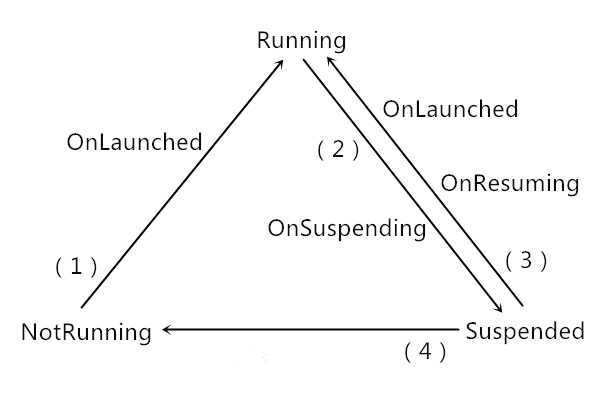Windows Phone 8.1 应用生命周期
2020-12-13 02:06
标签:style c class blog code java
一、“后退键”不会终止应用 关于 Windows Phone 8.1
的应用生命周期,第一个要知道的关键就是:“后退键”不会终止应用! 在 8.0 时代,不断的按下“后退键”就可以完全的关闭并且终止应用,但在 8.1
中,这样的行为只会让应用处在 Suspended(挂起)状态,可以通过长按“后退键”进入多任务界面查看。 那如果还想像 8.0
一样终止应用呢?(虽然不推荐也没有必要)可以在多任务界面点击应用右上角的“叉叉”或者向下滑。 二、应用生命周期 应用的三个状态分别是: A:NotRunning 也就是还没开启过应用,在多任务界面没有该应用时。 B:Running 在屏幕上显示的应用就是 Running 状态,同时只会有 1 个应用处于 Running
状态。 C:Suspended 不在屏幕上显示并能在多任务界面查看的应用则处于 Suspended(挂起)状态。 三种状态间切换的操作: (1)NotRunning -> Running 要从 NotRunning 切换到 Running
状态,其实也就是开启应用,可通过点击应用磁贴、应用间协议启动、Cortana等方式。 在状态的切换过程中会触发 OnLaunched 事件。 (2)Running -> Suspended 当应用不再占据屏幕时则从 Running 切换到 Suspended
状态,可以是“Win”键、“返回键”,有电话打来时也会挂起。 在状态的切换过程中会触发 OnSuspending 事件。 (3)Suspended -> Running 如果在应用挂起状态时没有因为某些原因(比如内存不足)导致应用终止的话,点击磁贴或者多任务切换都会让应用从
Suspender 返回到 Running 状态。 在状态的切换过程中会依次触发 OnResuming 和 OnLaunched
事件。 (4)Suspended -> NotRunning 如果在应用挂起状态时因为某些原因(比如内存不足)导致应用终止的话,则会从 Suspended 变成
NotRunning 状态。 在这过程不会触发任何事件。 三、OnSuspending 因为应用在挂起状态时,并不能预测应用是否会因为某些原因(比如内存不足)而终止,而在这终止过程中也没有事件让开发者处理应用数据,所以只能在应用将要挂起时准备。因此
OnSuspending 事件变得十分重要。 若要使用 OnSuspending 方法则先要在构造函数中添加对其的引用: 而在 OnSuspending
方法中可以根据需要保存页面数据,比如输入框内的文本、页面导航历史等,可以通过保存在应用独立存储中或利用 NavigationHelper 和
SuspensionManager 类等: 如果只想保存某个页面的信息则可以在 SaveState 中保存: NavigationHelper 和 SuspensionManager 类是添加基本页时
Visual Studio 自动添加的: 四、OnResuming 既然在 OnSuspending 和 SaveState 方法中保存了必要数据,就可以在
OnResuming 和 LoadState 方法中获取之前保存的数据: 五、OnLaunched 首先,在 OnLaunched 方法中可以通过 e.PreviousExecutionState
了解到应用之前的状态。 状态包括: (1)CloseByUser:被用户主动在多任务界面中关闭 (2)NotRunning:没有启动过 (3)Running:启动中 (4)Terminated:挂起状态时因内存不足被系统终止 (5)Suspended:挂起状态 因此,可以通过对此的判断,根据不同情况处理应用: 六、注意 以上的方法尽量使用异步操作,不要进行大量的复杂操作。 Windows Phone 8.1 应用生命周期,搜素材,soscw.com Windows Phone 8.1 应用生命周期 标签:style c class blog code java 原文地址:http://www.cnblogs.com/lonelyxmas/p/3756693.html
public App()
{
this.InitializeComponent();
this.Suspending += OnSuspending;
}

async void OnSuspending(object sender, SuspendingEventArgs e)
{
SuspendingDeferral deferral = e.SuspendingOperation.GetDeferral();
await this.SaveStateToLocalFile(Data.Value);
await SuspensionManager.SaveAsync();
deferral.Complete();
}

private void NavigationHelper_SaveState(object sender, SaveStateEventArgs e)
{
e.PageState["isEditing"] = true;
e.PageState["currentText"] = this.viewModel.DataItem.Title;
}


public class NavigationHelper : DependencyObject
{
private Page Page { get; set; }
private Frame Frame { get { return this.Page.Frame; } }
public NavigationHelper(Page page)
{
this.Page = page;
this.Page.Loaded += (sender, e) =>
{
WINDOWS_PHONE_APP
Windows.Phone.UI.Input.HardwareButtons.BackPressed += HardwareButtons_BackPressed;
e
if
};
this.Page.Unloaded += (sender, e) =>
{
WINDOWS_PHONE_APP
Windows.Phone.UI.Input.HardwareButtons.BackPressed -= HardwareButtons_BackPressed;
e
if
};
}
#region Navigation support
RelayCommand _goBackCommand;
RelayCommand _goForwardCommand;
public RelayCommand GoBackCommand
{
get
{
if (_goBackCommand == null)
{
_goBackCommand = new RelayCommand(
() => this.GoBack(),
() => this.CanGoBack());
}
return _goBackCommand;
}
set
{
_goBackCommand = value;
}
}
public RelayCommand GoForwardCommand
{
get
{
if (_goForwardCommand == null)
{
_goForwardCommand = new RelayCommand(
() => this.GoForward(),
() => this.CanGoForward());
}
return _goForwardCommand;
}
}
public virtual bool CanGoBack()
{
return this.Frame != null && this.Frame.CanGoBack;
}
public virtual bool CanGoForward()
{
return this.Frame != null && this.Frame.CanGoForward;
}
public virtual void GoBack()
{
if (this.Frame != null && this.Frame.CanGoBack) this.Frame.GoBack();
}
public virtual void GoForward()
{
if (this.Frame != null && this.Frame.CanGoForward) this.Frame.GoForward();
}
#if WINDOWS_PHONE_APP
private void HardwareButtons_BackPressed(object sender, Windows.Phone.UI.Input.BackPressedEventArgs e)
{
if (this.GoBackCommand.CanExecute(null))
{
e.Handled = true;
this.GoBackCommand.Execute(null);
}
}
#else
private void CoreDispatcher_AcceleratorKeyActivated(CoreDispatcher sender,
AcceleratorKeyEventArgs e)
{
var virtualKey = e.VirtualKey;
if ((e.EventType == CoreAcceleratorKeyEventType.SystemKeyDown ||
e.EventType == CoreAcceleratorKeyEventType.KeyDown) &&
(virtualKey == VirtualKey.Left || virtualKey == VirtualKey.Right ||
(int)virtualKey == 166 || (int)virtualKey == 167))
{
var coreWindow = Window.Current.CoreWindow;
var downState = CoreVirtualKeyStates.Down;
bool menuKey = (coreWindow.GetKeyState(VirtualKey.Menu) & downState) == downState;
bool controlKey = (coreWindow.GetKeyState(VirtualKey.Control) & downState) == downState;
bool shiftKey = (coreWindow.GetKeyState(VirtualKey.Shift) & downState) == downState;
bool noModifiers = !menuKey && !controlKey && !shiftKey;
bool onlyAlt = menuKey && !controlKey && !shiftKey;
if (((int)virtualKey == 166 && noModifiers) ||
(virtualKey == VirtualKey.Left && onlyAlt))
{
e.Handled = true;
this.GoBackCommand.Execute(null);
}
else if (((int)virtualKey == 167 && noModifiers) ||
(virtualKey == VirtualKey.Right && onlyAlt))
{
e.Handled = true;
this.GoForwardCommand.Execute(null);
}
}
}
private void CoreWindow_PointerPressed(CoreWindow sender,
PointerEventArgs e)
{
var properties = e.CurrentPoint.Properties;
if (properties.IsLeftButtonPressed || properties.IsRightButtonPressed ||
properties.IsMiddleButtonPressed) return;
bool backPressed = properties.IsXButton1Pressed;
bool forwardPressed = properties.IsXButton2Pressed;
if (backPressed ^ forwardPressed)
{
e.Handled = true;
if (backPressed) this.GoBackCommand.Execute(null);
if (forwardPressed) this.GoForwardCommand.Execute(null);
}
}
#endif
#endregion
#region Process lifetime management
private String _pageKey;
public event LoadStateEventHandler LoadState;
public event SaveStateEventHandler SaveState;
public void OnNavigatedTo(NavigationEventArgs e)
{
var frameState = SuspensionManager.SessionStateForFrame(this.Frame);
this._pageKey = "Page-" + this.Frame.BackStackDepth;
if (e.NavigationMode == NavigationMode.New)
{
var nextPageKey = this._pageKey;
int nextPageIndex = this.Frame.BackStackDepth;
while (frameState.Remove(nextPageKey))
{
nextPageIndex++;
nextPageKey = "Page-" + nextPageIndex;
}
if (this.LoadState != null)
{
this.LoadState(this, new LoadStateEventArgs(e.Parameter, null));
}
}
else
{
if (this.LoadState != null)
{
this.LoadState(this, new LoadStateEventArgs(e.Parameter, (Dictionary


internal sealed class SuspensionManager
{
private static Dictionarystring, object> _sessionState = new Dictionarystring, object>();
private static List
void OnResuming(object sender, object e)
{
Data.Value += this.CalculateOffsetTimeInDecimalSeconds(this.suspensionTime);
}

private void NavigationHelper_LoadState(object sender, LoadStateEventArgs e)
{
if ((e.PageState != null) && e.PageState.ContainsKey("isEditing"))
{
this.viewModel.SetEditMode();
this.viewModel.DataItem.Title = e.PageState["currentText"] as string;
}
}


protected async override void OnLaunched(LaunchActivatedEventArgs e)
{
Frame rootFrame = Window.Current.Content as Frame;
if (rootFrame == null)
{
rootFrame = new Frame();
SuspensionManager.RegisterFrame(rootFrame, "AppFrame");
rootFrame.Language = Windows.Globalization.ApplicationLanguages.Languages[0];
if (e.PreviousExecutionState == ApplicationExecutionState.Terminated)
{
try
{
await SuspensionManager.RestoreAsync();
}
catch (SuspensionManagerException)
{
}
}
Window.Current.Content = rootFrame;
}
if (rootFrame.Content == null)
{
rootFrame.Navigate(typeof(MainPage), e.Arguments);
}
Window.Current.Activate();
}
